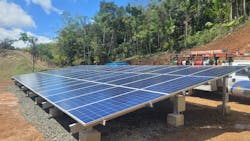Update: Confusion still persists about the difference between solar and solar microgrids. First published in 2016, this article explains why it’s important for energy consumers to know the difference.
It’s a surprise to many when they learn that their grid-connected solar panels can _not_ keep the lights on during a power outage.
This was a lesson the Northeast US learned the hard way during Sandy, the 2012 superstorm that knocked out power to 8 million people. Two weeks or more without electricity, solar panel owners were venting to the media. Few realized that absent a battery and advanced inverter, their solar homes would go dark.
Four years later, the misunderstanding persists. Homeowners, communities and businesses still install solar panels — sometimes making large capital investments — under the false presumption that solar will keep the lights on when the grid fails.
“I find that people all the time mistakenly believe that their solar panels will provide them with power during an outage,” said David Chiesa, S&C Electric’s former director of business development and currently vice president for global sales and BD at CTC Global.“It never dawns on them — and frankly why would it — that electrically you need a voltage source to be able to synch to.”
Most of the solar panels in the U.S. function through a grid connection. The grid goes down and so do they.
Why don’t more people know this? The problem is partially due to semantics. Many people do not yet understand the difference between solar and a solar microgrid. They tend to use the words interchangeably, describing the panels on their homes, businesses or community buildings as microgrids when in fact they do not have microgrid capabilities.
The difference between solar and solar microgrids
What is the difference? Both generate power with solar, but a solar microgrid also can island from the grid, a crucial ability.
Envision a storm where trees and branches are knocking down power lines. The electricity goes out in one neighborhood, then the next, then the next. Interconnected to the grid, the solar panels stop working too.
Most advanced microgrids are grid-connected too. But when their control software senses the disruption coming, they can disconnect and rely on their own solar and other distributed energy resources. So even when those around them are in the dark, microgrid customers have power.
In simplest terms, solar offers green energy; solar microgrids offer green energy plus electric reliability.
The difference between community solar and community microgrids
As if there is not enough confusion about solar versus solar microgrids, now two new terms have entered energy’s vocabulary: community solar and community microgrids.
The two offer real — but very different — benefits. And again the terms are sometimes interchanged in popular speech.
Community solar is a green energy play, designed largely for those who cannot put solar panels on their roofs for one reason or another. They may rent, or perhaps their roofs are shaded or otherwise insufficient for solar panels.
Ownership models vary for community solar. (See graphic below.) But generally, a community solar project involves a developer who builds the project and homeowners or local businesses who pay to share the benefits of the project. The homes or businesses are not physically connected to the project, so they do not receive its energy. (That’s sent into the utility grid.) Instead, they receive financial benefits, often in the form of lower utility bills.
Community microgrids, on the other hand, are designed to serve a public purpose, typically guaranteeing power for critical services in a storm or emergency. Often they are centered around hospitals, emergency centers, police departments, grocery stores, banks and the like.
Community microgrids are meant to “provide for the basic needs of the populace” during an outage, Chiesa said. “The idea is that you provide a place for people to go where they can receive shelter, heat, charge their cell phones.”
How about a community solar microgrid?
Chiesa raises the intriguing idea of making community solar installations into microgrids.
“It’s a fantastic thing when there is already a solar field present and you can then build your microgrid around that because it really lowers the overall cost. Typically, the largest cost incurred in the microgrid is the distributed energy resources,” he said.
There are some complications, however, in starting with community solar and then transitioning to a microgrid. The problems are not technical, according to Chiesa. Instead, they have to do with pairing the two business models.
For example, those participating in the community solar project may not necessarily be connected to the microgrid. When an outage occurs, the microgrid would co-opt energy from the solar field to ensure reliability to the hospitals, police stations, water treatment facilities or other buildings that are part of the microgrid. So an agreement would need to be in place with the community solar participants that allows the microgrid to use the solar power in an emergency.
It’s also not clear how those who own the community solar project would get paid when the solar farm goes into microgrid mode, since the normal solar revenue streams (such as net metering) no longer apply.
By palidachan/Shutterstock.com
Think microgrid first
A solution is to start thinking ‘microgrid’ before the community solar project is installed. When a solar developer applies to build a project, local jurisdictions that are forward-thinking might consider requiring that the community solar will have the ability to go into microgrid mode. They might include the requirement within contract clauses in leases or other legal agreements.
Community solar and community microgrids each offer a lot of value. So marrying them would bolster two valuable models that together could green the grid and increase its electric reliability.
Bottom line? If you’re talking to a solar installer, and you want not just clean, but also reliable energy, ask the question: Is this a microgrid? And if not, how can we make it one?
Read more articles like this, free of charge, by subscribing to the Microgrid Knowledge newsletter.







